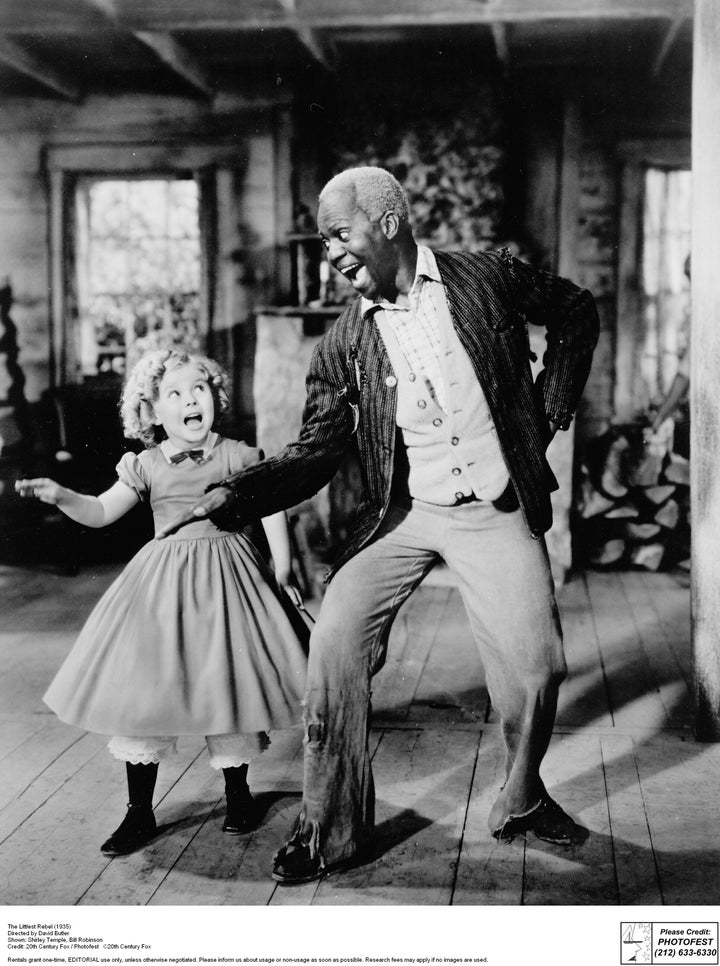
As I expected when posting a blog on National Tap Dance Day asking for your memories of first seeing tap dance, the majority of responses were those of watching Shirley Temple and Bill Robinson -- hand in hand -- tap dancing up and down a flight of stairs. Fred Astaire dancing solo or cheek-to-cheek with Ginger Rogers in Top Hat was also a great fave, as was the dancing of Sammy Davis Jr., Donald O'Connor, Gene Kelly, Gregory Hines and the great Nicholas Brothers -- but what about the women? I was especially pleased with the shout-out to Arthur Duncan, who kept tap dance alive on television from 1964 to 1975 in some 575 programs on the Lawrence Welk Show.
For those who remembered only Shirley Temple, you should know that Bill Robinson-- little Shirley's master teacher and long-time friend who acted and danced with her in The Little Colonel, The Littlest Rebel, Rebecca of Sunnybrook Farm, and Just Around the Corner, and who choreographed the 1936 Dimples -- is implicit in memory. Despite Robinson's appearances in several black-cast musical films, such as Dixiana (1929), Harlem is Heaven (1932) and King for a Day (1934), he did not blossom as a major film studio commodity until he was teamed with Shirley Temple in The Little Colonel (1935). It was the first of a series of Hollywood films that cast Robinson as a loyal, self-effacing "Uncle Tom" who dutifully served his masters. As Walker the houseboy, he was regularly insulted and berated by Lionel Barrymore, the southern patriarch, and he stoically accepted the abuse. Only once in the movie was the spark of resistance that danced behind Robinson's eyes ever affirmed -- when the patriarch admitted that he was "an old fool": instead of delivering his stoic "yessur," Robinson flashed a broad smile and, walking away, intoned "Yes . . . sir!" Robinson was chipper and effervescent when he playfully jibed with the house servant played by Hattie McDaniel; he was even more so when he enticed the Southern patriarch's six-year-old granddaughter (Temple) to go upstairs to bed by teaching her his famous stair dance. She took his hand and learned his steps, and they danced their way into cinema history as the first interracial tap-dancing couple, albeit a six-year-old white girl and fifty-seven-year-old black man.
"Theirs was the perfect interracial love match. For surely nothing would come of it," writes Donald Bogle. Though surely, he adds, The Littlest Rebel, which cast Robinson as Uncle Willy, the protective guardian-companion who accompanies Temple in search of her father who is captured by Union troupes during the Civil War, was "certainly the first time in the history of motion pictures that a black servant was made responsible for a white life." Within the restriction of the servant role, Robinson masterfully stretched it into that which was more paternal, playing teacher, mentor and sage.
In a profusion of blonde curls and dimples, Shirley Jane Temple first tap-danced across a movie screen and into the American consciousness in the 1934 Fox film Stand Up and Cheer. Joining the Irish-American tap dancer James Dunn in a song-and-dance number, "Baby, Take a Bow," she instantly captured the audience's affection, despite her appearance in this single scene. For almost a decade, Temple had no equal in generating box office attendance. She enchanted children and adults watching her for the first time, inspiring droves to try tap dancing -- to learn to dance, as she had done from her Uncle Willy. In 1934 Temple appeared in eight films, with no tap dance of note. It was not until The Little Colonel, when she first worked with Robinson, that her tap dancing -- combined with an acting style that comprised such mannerisms as a pursed mouth, wide-open eyes, a flat-footed stance with arms akimbo, a piquant smile, and mocked anger -- established her as the darling of Hollywood.
Robinson was performing on the Paramount Theater stage circuit when he was scouted for a role in The Little Colonel. "The first thing I noticed was the way his arms and legs moved with a silky, muscular grace," Temple recalled. "He was square-jawed and shiny cheeked, his great round eyes showing whites all around. I was instantly attracted." When they started across the studio lot, Robinson walked a step ahead; as he noticed her hurrying to catch up, he shortened his stride to accommodate hers. "I kept reaching for his hand... He stopped short, bent over me, his eyes wide and rows of brilliant teeth in a wide smile. When he took my hand in his, it felt large and cool."
There was something about Robinson as a highly accomplished adult male dancer, matching his steps to those of an adorable little girl, which brought both pleasure and a release of anxiety to audiences in the 1930s. I fantasize that with so many nostalgic remembrances of Temple and Robinson -- a black male and white female tap-dancing with pleasure and glee across the silver screen in one of the most fiercely racist and segregated decades of the century -- perhaps we were presented, subliminally, with the ideal possibility that there might someday be an end to racism in our society! I know, I'm only dreaming... So what do you make of Bill and Shirley?